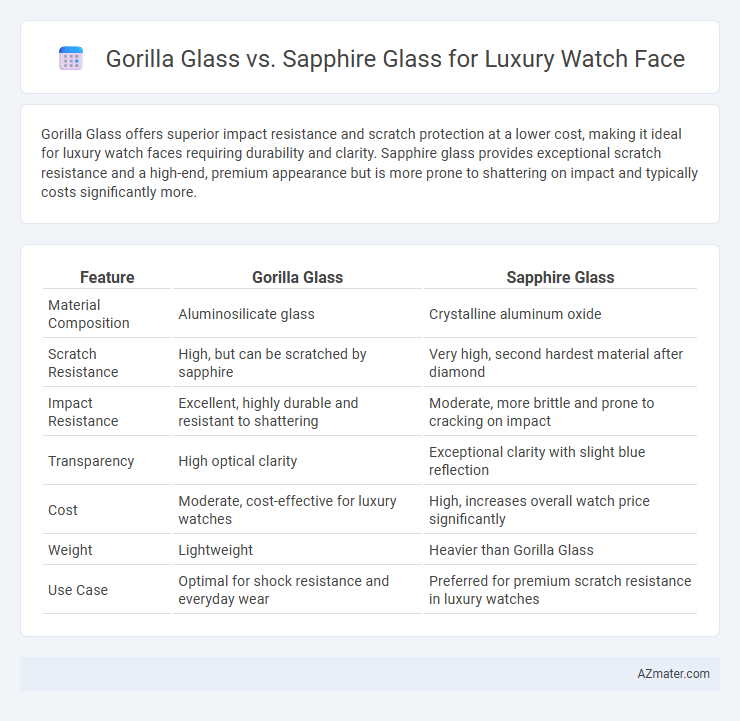Gorilla Glass offers superior impact resistance and scratch protection at a lower cost, making it ideal for luxury watch faces requiring durability and clarity. Sapphire glass provides exceptional scratch resistance and a high-end, premium appearance but is more prone to shattering on impact and typically costs significantly more.
Table of Comparison
| Feature | Gorilla Glass | Sapphire Glass |
|---|---|---|
| Material Composition | Aluminosilicate glass | Crystalline aluminum oxide |
| Scratch Resistance | High, but can be scratched by sapphire | Very high, second hardest material after diamond |
| Impact Resistance | Excellent, highly durable and resistant to shattering | Moderate, more brittle and prone to cracking on impact |
| Transparency | High optical clarity | Exceptional clarity with slight blue reflection |
| Cost | Moderate, cost-effective for luxury watches | High, increases overall watch price significantly |
| Weight | Lightweight | Heavier than Gorilla Glass |
| Use Case | Optimal for shock resistance and everyday wear | Preferred for premium scratch resistance in luxury watches |
Introduction to Watch Crystal Materials
Gorilla Glass and Sapphire Glass are leading watch crystal materials renowned for their durability and clarity. Gorilla Glass provides exceptional scratch resistance with added impact protection due to its chemically strengthened composition, making it a cost-effective choice for luxury watch faces. Sapphire Glass offers superior hardness on the Mohs scale, ensuring high scratch resistance and an enhanced premium feel, ideal for high-end timepieces demanding long-lasting clarity and elegance.
What is Gorilla Glass?
Gorilla Glass is a chemically strengthened, alkali-aluminosilicate sheet glass developed by Corning, renowned for its exceptional scratch resistance and durability in luxury watch faces. Its impact ion-exchange process creates a compressive surface layer, enhancing toughness while maintaining clarity and thinness crucial for premium timepieces. Widely adopted in high-end watches, Gorilla Glass offers a lightweight, shatter-resistant alternative to traditional sapphire glass, balancing cost-effectiveness with robust performance.
What is Sapphire Glass?
Sapphire glass is a synthetic, crystalline material renowned for its exceptional hardness and scratch resistance, often used in luxury watch faces to provide superior durability and clarity. Composed primarily of crystallized aluminum oxide, it ranks 9 on the Mohs scale, making it second only to diamond in hardness, which protects the watch from daily wear and tear while maintaining a pristine appearance. This material's optical transparency and resistance to shattering make it a premium choice compared to Gorilla Glass, which is chemically strengthened but generally less scratch resistant.
Durability Comparison: Gorilla vs. Sapphire
Sapphire glass offers superior scratch resistance and hardness, ranking 9 on the Mohs scale compared to Gorilla Glass's 6-7, making it highly durable for luxury watch faces. Gorilla Glass, while more impact-resistant and less prone to shattering, is more susceptible to scratches and abrasions during daily wear. Luxury watches often balance these properties by selecting sapphire for premium scratch protection and Gorilla Glass for enhanced toughness and breakage resistance.
Scratch Resistance: Which Glass Performs Better?
Sapphire glass offers superior scratch resistance compared to Gorilla glass, ranking 9 on the Mohs hardness scale versus Gorilla glass's approximate rating of 6 to 7. Its crystalline structure makes it highly resistant to everyday abrasions commonly encountered by luxury watch faces. However, Gorilla glass provides better shatter resistance and flexibility, appealing to those prioritizing impact durability alongside scratch protection.
Clarity and Transparency Differences
Gorilla Glass offers superior clarity with high light transmission and low distortion, making it ideal for detailed watch faces where readability is crucial. Sapphire glass provides excellent transparency but can exhibit slight optical imperfections under certain angles due to its crystalline structure. The difference in clarity between the two materials often influences luxury watch designs prioritizing either scratch resistance (sapphire) or enhanced visual sharpness (Gorilla Glass).
Weight and Comfort Factors
Gorilla Glass offers a lighter weight compared to Sapphire Glass, contributing to enhanced comfort for luxury watch wearers due to reduced overall wrist strain. Sapphire Glass, while significantly more scratch-resistant, tends to be heavier, potentially impacting prolonged wear comfort. Choosing Gorilla Glass allows luxury watches to maintain durability with superior comfort, especially for users prioritizing lightweight design.
Cost Analysis: Gorilla Glass vs. Sapphire Glass
Gorilla Glass offers a cost-effective solution for luxury watch faces, typically priced lower due to its mass production and widespread use in consumer electronics. Sapphire glass, known for its superior scratch resistance and durability, incurs higher manufacturing costs stemming from its complex crystallization process and limited production scale. The price difference significantly impacts luxury watch pricing, with sapphire glass often justifying premium pricing through enhanced prestige and longevity.
Popular Luxury Watch Brands and Their Choices
Rolex predominantly uses sapphire glass for its luxury watch faces, prized for its exceptional scratch resistance and clarity, enhancing the brand's premium appeal. TAG Heuer balances durability and cost by utilizing both sapphire and Gorilla Glass in select models, offering a mix of toughness and affordability. Patek Philippe exclusively opts for high-grade sapphire crystal, reinforcing its reputation for elegance and superior protection against daily wear.
Which Glass is Best for Luxury Watches?
Sapphire glass excels in luxury watch faces due to its superior scratch resistance and hardness, rating 9 on the Mohs scale, ensuring long-lasting clarity and durability. Gorilla Glass, composed of chemically strengthened aluminosilicate, offers better impact resistance and lightweight properties but falls short in scratch resistance compared to sapphire. For luxury watches where premium aesthetics and scratch-free surfaces are paramount, sapphire glass remains the preferred choice among high-end watchmakers.

Infographic: Gorilla glass vs Sapphire glass for Luxury watch face
 azmater.com
azmater.com